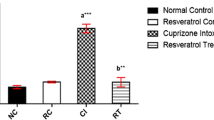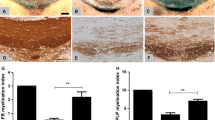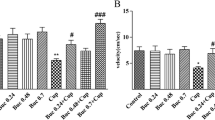Abstract
Multiple sclerosis (MS) is an autoimmune, demyelinating disease of the central nervous system. The protective effects of melatonin (MLT) on various neurodegenerative diseases, including MS, have been suggested. In the present study, we examined the effect of MLT on demyelination, apoptosis, inflammation, and behavioral dysfunctions in the cuprizone toxic model of demyelination. C57BL/6J mice were fed a chaw containing 0.2 % cuprizone for 5 weeks and received two doses of MLT (50 and 100 mg/kg) intraperitoneally for the last 7 days of cuprizone diet. Administration of MLT improved motor behavior deficits induced by cuprizone diet. MLT dose-dependently decreased the mean number of apoptotic cells via decreasing caspase-3 and Bax as well as increasing Bcl-2 levels. In addition, MLT significantly enhanced nuclear factor-κB activation and decreased heme oxygenase-1 level. However, MLT had no effect on interleukin-6 and myelin protein production. Our data revealed that MLT improved neurological deficits and enhanced cell survival but was not able to initiate myelin production in the cuprizone model of demyelination. These findings may be important for the design of potential MLT therapy in demyelinating disorders, such as MS.





Similar content being viewed by others
Abbreviations
- MLT:
-
Melatonin
- CNS:
-
Central nervous system
- ECL:
-
Electrochemiluminescence
- EAE:
-
Experimental autoimmune encephalomyelitis
- H&E:
-
Hematoxylin and eosin
- HO:
-
Heme oxygenase
- IL-6:
-
Interleukin-6
- LFB:
-
Luxol Fast Blue
- MS:
-
Multiple sclerosis
- NFκB:
-
Nuclear factor-κB
- PFA:
-
Paraformaldehyde
- BBB:
-
Blood brain barrier
- PNS:
-
Peripheral nervous system
- PLP:
-
Proteolipid protein
- PMP-22:
-
Peripheral myelin protein 22
- TUNEL:
-
Terminal deoxynucleotidyl transferase-mediated dUTP nick-end labeling
References
Lassmann H, Brück W, Lucchinetti CF (2007) The immunopathology of multiple sclerosis: an overview. Brain Pathol 17(2):210–8. doi:10.1111/j.1750-3639.2007.00064.x
Brück W, Pförtner R, Pham T, Zhang J, Hayardeny L, Piryatinsky V, Hanisch UK, Regen T et al (2012) Reduced astrocytic NF-κB activation by laquinimod protects from cuprizone-induced demyelination. Acta Neuropathol 124(3):411–24. doi:10.1007/s00401-012-1009-1
Skripuletz T, Bussmann JH, Gudi V, Koutsoudaki PN, Pul R, Moharregh‐Khiabani D, Lindner M, Stangel M (2010) Cerebellar cortical demyelination in the murine cuprizone model. Brain Pathol 20(2):301–12. doi:10.1111/j.1750-3639.2009.00271.x
Kipp M, Clarner T, Dang J, Copray S, Beyer C (2009) The cuprizone animal model: new insights into an old story. Acta neuropathol 118(6):723–36. doi:10.1007/s00401-009-0591-3
Matsushima GK, Morell P (2001) The neurotoxicant, cuprizone, as a model to study demyelination and remyelination in the central nervous system. Brain Pathol 11(1):107–16. doi:10.1111/j.1750-3639.2001.tb00385.x
Kondo A, Nakano T, Suzuki K (1987) Blood-brain barrier permeability to horseradish peroxidase in twitcher and cuprizone-intoxicated mice. Brain Res 425(1):186–90. doi:10.1016/0006-8993(87)90499-9
Brzezinski A (1997) Melatonin in humans. N Engl J Med 336(3):186–95. doi:10.1056/NEJM199701163360306
Carrillo-Vico A, Lardone PJ, Álvarez-Sánchez N, Rodríguez-Rodríguez A, Guerrero JM (2013) Melatonin: buffering the immune system. International journal of molecular sciences. Int J Mol Sci 14(4):8638–83. doi:10.3390/ijms14048638
Villapol S, Fau S, Renolleau S, Biran V, Charriaut-Marlangue C, Baud O (2011) Melatonin promotes myelination by decreasing white matter inflammation after neonatal stroke. Pediatr Res 69(1):51–5. doi:10.1203/PDR.0b013e3181fcb40b
Dubocovich ML, Delagrange P, Krause DN, Sugden D, Cardinali DP, Olcese J (2010) International Union of Basic and Clinical Pharmacology. LXXV. Nomenclature, classification, and pharmacology of G protein-coupled melatonin receptors. Pharmacol Rev 62(3):343–80. doi:10.1124/pr.110.002832
Witt-Enderby PA, Bennett J, Jarzynka MJ, Firestine S, Melan MA (2003) Melatonin receptors and their regulation: biochemical and structural mechanisms. Life Sci 72(20):2183–98. doi:10.1016/S0024-3205(03)00098-5
Molinari EJ, North PC, Dubocovich ML (1996) 2-[125I]iodo-5-methoxycarbonylamino-N-acetyltryptamine: a selective radioligand for the characterization of melatonin ML2 binding sites. Eur J Pharmacol 301(1):159–68. doi:10.1016/0014-2999(95)00870-5
Wang X (2009) The antiapoptotic activity of melatonin in neurodegenerative diseases. CNS Neurosci Ther 15(4):345–57. doi:10.1111/j.1755-5949.2009.00105.x
Esposito E, Cuzzocrea S (2010) Antiinflammatory activity of melatonin in central nervous system. Curr Neuropharmacol 8(3):228. doi:10.2174/157015910792246155
Esposito E, Paterniti I, Mazzon E, Bramanti P, Cuzzocrea S (2010) Melatonin reduces hyperalgesia associated with inflammation. J Pineal Res 49(4):321–31. doi:10.1111/j.1600-079X.2010.00796.x
Kang JC, Ahn M, Kim YS, Moon C, Lee Y, Wie MB, Lee YJ, Shin T (2001) Melatonin ameliorates autoimmune encephalomyelitis through suppression of intercellular adhesion molecule-1. J Vet Sci 2(2):85–9
Bahamonde C, Conde C, Agüera E, Lillo R, Luque E, Gascón F, Feijóo M, Cruz AH et al (2014) Elevated melatonin levels in natalizumab-treated female patients with relapsing-remitting multiple sclerosis: relationship to oxidative stress. Eur J Pharmacol 730:26–30. doi:10.1016/j.ejphar.2014.02.020
Azami K, Etminani M, Tabrizian K, Salar F, Belaran M, Hosseini A, Hosseini-Sharifabad A, Sharifzadeh M (2010) The quantitative evaluation of cholinergic markers in spatial memory improvement induced by nicotine–bucladesine combination in rats. Eur J Pharmacol 636(1):102–7. doi:10.1016/j.ejphar.2010.03.041
Prut L, Belzung C (2003) The open field as a paradigm to measure the effects of drugs on anxiety-like behaviors: a review. Eur J Pharmacol 463(1):3–33. doi:10.1016/S0014-2999(03)01272-X
Vakilzadeh G, Khodagholi F, Ghadiri T, Darvishi M, Ghaemi A, Noorbakhsh F, Gorji A, Sharifzadeh M (2015) Protective effect of a cAMP Analogue on behavioral deficits and neuropathological changes in cuprizone model of demyelination. Mol Neurobiol 52(1):130–41. doi:10.1007/s12035-014-8857-8
Bradford MM (1976) A rapid and sensitive method for the quantitation of microgram quantities of protein utilizing the principle of protein-dye binding. Anal Biochem 72(1):248–54
Ghadiri T, Sharifzadeh M, Khodagholi F, Modarres Mousavi SM, Hassanzadeh G, Zarrindast MR, Gorji A (2014) A novel traumatic brain injury model for induction of mild brain injury in rats. J Neurosci Methods 233:18–27. doi:10.1016/j.jneumeth
Kim JH, Budde MD, Liang H-F, Klein RS, Russell JH, Cross AH et al (2006) Detecting axon damage in spinal cord from a mouse model of multiple sclerosis. Neurobiol Dis 21(3):626–32. doi:10.1016/j.nbd.2005.09.009
Ghaemi A, Sajadian A, Khodaie B, Lotfinia AA, Lotfinia M, Aghabarari A, Khaleghi Ghadiri M, Meuth S et al (2014) Immunomodulatory effect of toll-like receptor-3 ligand Poly I:C on cortical spreading depression. Mol Neurobiol. doi:10.1007/s12035-014-8995-z, Nov 23
Jafarian M, Karimzadeh F, Alipour F, Attari F, Lotfinia AA, Speckmann EJ, Zarrindast MR, Gorji A (2015) Cognitive impairments and neuronal injury in different brain regions of a genetic rat model of absence epilepsy. Neuroscience 298:161–70. doi:10.1016/j.neuroscience.2015.04.033
Liebetanz D, Merkler D (2006) Effects of commissural de-and remyelination on motor skill behaviour in the cuprizone mouse model of multiple sclerosis. Exp Neurol 202(1):217–24. doi:10.1016/j.expneurol.2006.05.032
Esposito E, Genovese T, Caminiti R, Bramanti P, Meli R, Cuzzocrea S (2009) Melatonin reduces stress‐activated/mitogen‐activated protein kinases in spinal cord injury. J Pineal Res 46(1):79–86. doi:10.1111/j.1600-079X.2008.00633.x
Srinivasan V, Lauterbach EC, Ho KY, Acuña-Castroviejo D, Zakaria R, Brzezinski A (2012) Melatonin in antinociception: its therapeutic applications. Curr Neuropharmacol 10(2):167. doi:10.2174/157015912800604489
Laste G, de Macedo IC, Rozisky JR, da Silva FR, Caumo W, Torres IL (2012) Melatonin administration reduces inflammatory pain in rats. J Pain Res 5:359–62. doi:10.2147/JPR.S34019
Hodges PW, Smeets RJ (2015) Interaction between pain, movement, and physical activity: short-term benefits, long-term consequences, and targets for treatment. Clin J Pain 31(2):97–107. doi:10.1097/AJP.0000000000000098
Curros-Criado MM, Herrero JF (2007) The antinociceptive effect of systemic gabapentin is related to the type of sensitization-induced hyperalgesia. J Neuroinflammation 4:15. doi:10.1186/1742-2094-4-15
Wang X, Fueroa BE, Stavrovskaya IG, Zhang Y, Sirianni AC, Zhu S et al (2009) Methazolamide and melatonin inhibit mitochondrial cytochrome C release and are neuroprotective in experimental models of ischemic injury. Stroke 40(5):1877–85. doi:10.1161/STROKEAHA.108.540765
Sun FY, Lin X, Mao LZ, Ge WH, Zhang LM, Huang YL et al (2002) Neuroprotection by melatonin against ischemic neuronal injury associated with modulation of DNA damage and repair in the rat following a transient cerebral ischemia. J Ppineal Res 33(1):48–56. doi:10.1034/j.1600-079X.2002.01891.x
Fuchs Y, Steller H (2011) Programmed cell death in animal development and disease. Cell 147(4):742–58. doi:10.1016/j.cell.2011.10.033
Negron JF, Lockshin RA (2004) Activation of apoptosis and caspase‐3 in zebrafish early gastrulae. Dev Dyn 231(1):161–70. doi:10.1002/dvdy.20124
Andrabi SA, Sayeed I, Siemen D, Wolf G, Horn TF (2004) Direct inhibition of the mitochondrial permeability transition pore: a possible mechanism responsible for anti-apoptotic effects of melatonin. FASEB J 18(7):869–71. doi:10.1096/fj.03-1031fje
Jang MH, Jung SB, Lee MH, Kim CJ, Oh YT, Kang I, Kim J, Kim EH (2005) Melatonin attenuates amyloid beta25-35-induced apoptosis in mouse microglial BV2 cells. Neurosci Lett 380(1):26–31. doi:10.1016/j.neulet.2005.01.003
Ling X, Zhang LM, Lu SD, Li XJ, Sun FY (1999) Protective effect of melatonin on injuried cerebral neurons is associated with bcl-2 protein over-expression. Zhongguo Yao Li Xue Bao 20(5):409–14
Hesse A, Wagner M, Held J, Brück W, Salinas-Riester G, Hao Z, Waisman A, Kuhlmann T (2010) In toxic demyelination oligodendroglial cell death occurs early and is FAS independent. Neurobio Dis 37(2):362–9. doi:10.1016/j.nbd.2009.10.016
Reiter RJ, Tan DX, Manchester LC, Qi W (2001) Biochemical reactivity of melatonin with reactive oxygen and nitrogen species. Cell Biochem Biophys 34(2):237–56. doi:10.1385/CBB:34:2:237
Raasch J, Zeller N, Van Loo G, Merkler D, Mildner A, Erny D, et al. (2011) IκB kinase 2 determines oligodendrocyte loss by non-cell-autonomous activation of NF-κB in the central nervous system. Brain. awq359. doi: 10.1093/brain/awq359
Brambilla R, Hurtado A, Persaud T, Esham K, Pearse DD, Oudega M, Bethea JR (2009) Transgenic inhibition of astroglial NF‐κB leads to increased axonal sparing and sprouting following spinal cord injury. J Neurochem 110(2):765–78. doi:10.1111/j.1471-4159.2009.06190.x
Carrillo-Vico A, Guerrero JM, Lardone PJ, Reiter RJ (2005) A review of the multiple actions of melatonin on the immune system. Endocrine 27(2):189–200. doi:10.1385/ENDO:27:2:189
Epstein FH, Barnes PJ, Karin M (1997) Nuclear factor-κB—a pivotal transcription factor in chronic inflammatory diseases. N Engl J Med 336(15):1066–71. doi:10.1056/NEJM199704103361506
Garcia-Maurino S, Gonzalez-Haba MG, Calvo JR, Rafii-El-Idrissi M, Sanchez-Margalet V, Goberna R et al (1997) Melatonin enhances IL-2, IL-6, and IFN-gamma production by human circulating CD4+ cells: a possible nuclear receptor-mediated mechanism involving T helper type 1 lymphocytes and monocytes. J Immunol 159(2):574–81
Cristofanon S, Uguccioni F, Cerella C, Radogna F, Dicato M, Ghibelli L, Diederich M (2009) Intracellular prooxidant activity of melatonin induces a survival pathway involving NF‐κB activation. Ann N Y Acad Sci 1171(1):472–8. doi:10.1111/j.1749-6632.2009.04896.x
Radogna F, Diederich M, Ghibelli L (2010) Melatonin: a pleiotropic molecule regulating inflammation. Biochem Pharmacol 80(12):1844–52. doi:10.1016/j.bcp.2010.07.041
Markus RP, Cecon E, Pires-Lapa MA (2013) Immune-pineal axis: nuclear factor κB (NF-kB) mediates the shift in the melatonin source from pinealocytes to immune competent cells. Int J Mol Sci 14(6):10979–97. doi:10.3390/ijms140610979
Willis D, Moore A, Frederick R, Willoughby D (1996) Heme oxygenase: a novel target for the modulation of inflammatory response. Nat Med 2(1):87–93. doi:10.1038/nm0196-87
Ganesh Yerra V, Negi G, Sharma SS, Kumar A (2013) Potential therapeutic effects of the simultaneous targeting of the Nrf2 and NF-κB pathways in diabetic neuropathy. Redox Biol 1(1):394–7. doi:10.1016/j.redox.2013.07.005
Tsunoda I, Fujinami RS (2002) Inside-Out versus Outside-In models for virus induced demyelination: axonal damage triggering demyelination. Springer Semin Immunopathol 24(2):105–25. doi:10.1007/s00281-002-0105-z
Deb C, Lafrance-Corey RG, Zoecklein L, Papke L, Rodriguez M, Howe CL (2009) Demyelinated axons and motor function are protected by genetic deletion of perforin in a mouse model of multiple sclerosis. J Neuropathol Exp Neurol 68(9):1037–48. doi:10.1097/NEN.0b013e3181b5417e
Bjartmar C, Trapp BD (2003) Axonal degeneration and progressive neurologic disability in multiple sclerosis. Neurotox Res 5(1-2):157–64
Kashani IR, Rajabi Z, Akbari M, Hassanzadeh G, Mohseni A, Eramsadati MK, Rafiee K, Beyer C et al (2014) Protective effects of melatonin against mitochondrial injury in a mouse model of multiple sclerosis. Exp Brain Res 232(9):2835–46. doi:10.1007/s00221-014-3946-5
Adamczyk-Sowa M, Pierzchala K, Sowa P, Polaniak R, Kukla M, Hartel M (2014) Influence of melatonin supplementation on serum antioxidative properties and impact of the quality of life in multiple sclerosis patients. J Physiol Pharmacol 65(4):543–50
Acknowledgments
This study was supported by the Shefa Neuroscience Research Center grant related to Dr-Thesis 26222, Tehran University of Medical Sciences, and Iran National Science Foundation (INSF).
Author information
Authors and Affiliations
Corresponding authors
Rights and permissions
About this article
Cite this article
Vakilzadeh, G., Khodagholi, F., Ghadiri, T. et al. The Effect of Melatonin on Behavioral, Molecular, and Histopathological Changes in Cuprizone Model of Demyelination. Mol Neurobiol 53, 4675–4684 (2016). https://doi.org/10.1007/s12035-015-9404-y
Received:
Accepted:
Published:
Issue Date:
DOI: https://doi.org/10.1007/s12035-015-9404-y




